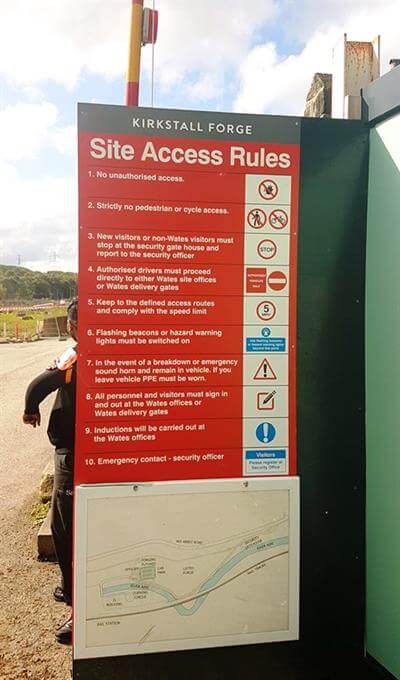Safety signs are a legal requirement for UK workplaces. Find out what they involve and when they apply in this quick guide from signage experts, FASTSIGNS® Leeds.
As an employer or site manager, it’s important to spend time making sure your workplace is updated with relevant safety signs and information. More than simply being practical, safety signage is a legal requirement within most working environments.

We help businesses of every kind with their safety signs, from schools and medical centres to manufacturing and construction sites. We’ve taken our knowledge and created this quick overview to help you get started with planning safety signs for your site.
What’s the legislation?
Under the Health and Safety (Safety Signs and Signals) Regulations 1996, UK employers have a responsibility to make sure their workplace is safely signposted. This involves making sure safety signs are in place and maintained in circumstances where there’s a significant risk to health and safety.
Why are safety signs required?
Safety signs are required wherever something poses a significant risk to health and safety, alerting employees to potential risks.
To determine where safety signs are necessary, employers first need to conduct a thorough risk assessment (made under the Management of Health and Safety at Work Regulations 1999). These assessments are designed to identify hazards and the associated risks, as well as the required measures that need to be taken.
It’s important to note that safety signs are not a substitute for other methods of control i.e. putting controls in place to prevent hazardous situations. Safety signs are only appropriate where their use can further reduce the risk.
What is safety signage?
A safety sign provides information or instruction about safety or health at work. This could be a prohibition (no access), warning (hazard), direction (fire escape) or mandatory (helmet must be worn) sign displayed next to the relevant risk.
This information can be communicated in many different ways, including:
- A signboard – printed board depicting words and/or iconography
- An illuminated sign – light-backed signage box with instructions, directions or warning
- A symbol or pictogram – is displayed on or nearby the hazard
- An acoustic signal – noise or recorded words, signalling a hazard, e.g. fire alarm
What safety signs do I need?
All working environments require some level of safety signage, for instance, fire exit notices. However, some organisations may require a range of signs for multiple purposes.
If you’re a business that operates machinery, you’ll need more safety signs. The results of your risk assessment will provide you with this information and your signage supplier will be able to advise you on the specific signs needed for each instance of risk.
What should my signs look like?
As outlined by the regulation guidelines, there are specific colours associated with warning signs. These are outlined in the table below:
| Colour | Meaning or purpose | Instruction and information |
|---|---|---|
| Red | Prohibition sign Danger alarm | Dangerous behaviour; stop; shutdown; emergency cut out devices; evacuate |
| Yellow/amber | Warning sign | Be careful; take precautions; examine |
| Blue | Mandatory sign | Specific behaviour or action, e.g. wear protective equipment |
| Green | Emergency escape First aid No danger | Doors; exits; escape routes; equipment and facilities Return to normal |
Signs should be clear and large enough to be seen and understood from the required distance. It’s important to avoid placing too many signs in close proximity, as this can become confusing. Safety signage needs to be made as easy as possible to understand.
How do I know people will understand them?
Most safety signs are self-explanatory. The symbols and colours that are used are universally recognised and have been designed to be easily understood. However, you should never assume this is the case. You need to account for all employees, some of which may be younger or less experienced. Your business may also require some more specific warnings that incorporate less commonly-known signals.
With every employee, it’s a good idea to make sure they’ve been shown all of the safety notices around your site. This will give you the chance to check they understand the meaning of the risk and explain how to act accordingly.
Do I need to maintain my signs?
Yes, it’s the responsibility of employers to make sure their signs are kept in a good condition and are legible at all times. They’re also legally bound to keep their safety signs updated, so it’s important to keep on top of your risk assessments to make sure all potential hazards are effectively labelled.
We hope you’ve found this a helpful overview. All of the information within this article was sourced from the document Safety signs and signals, Guidance on Regulations, where you can find further details on safety signage requirements. Please note, that the information provided above is an overview and shouldn’t form the basis of your safety signage policies alone.
Do you need safety signs for your site? We can help. Our signage experts carry out free site surveys where they assess your space and help you find the best solution for the job. Talk to us today about up-to-date safety signage for your business.